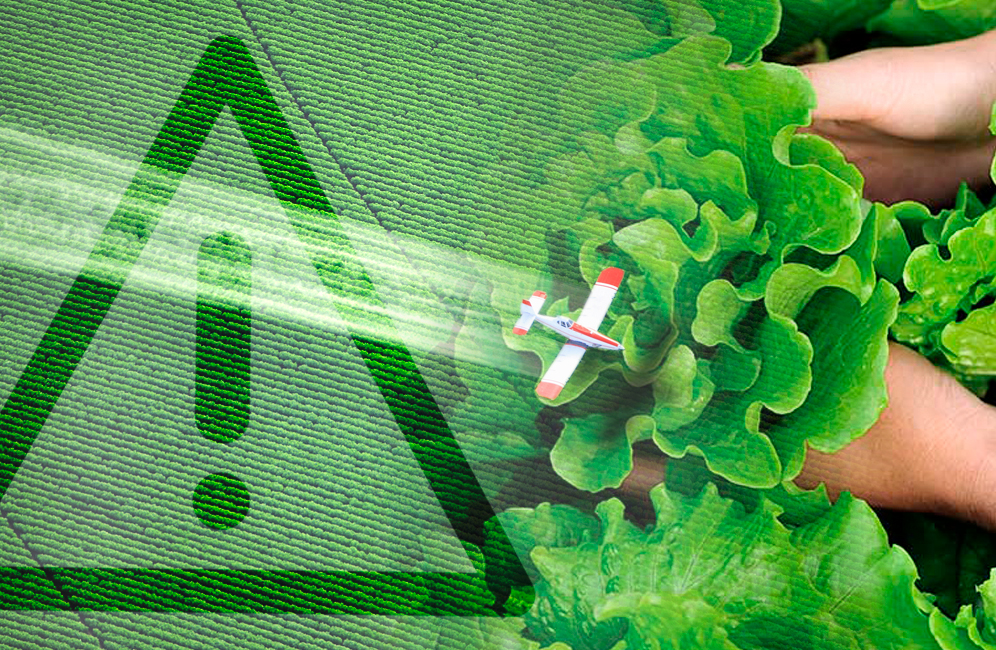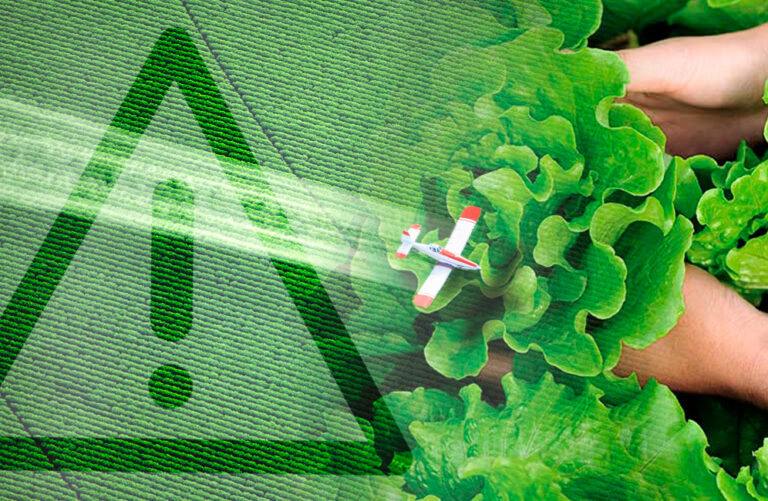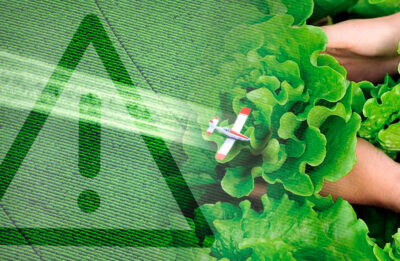Spring of 2018, a border crossing in Medyka, Podkarpacie. A 50-year-old Ukrainian is standing indifferently next to a Volkswagen being searched by Polish customs officers: they empty the fuel tank and pump out windscreen washer fluid. Why? They have discovered tubes in the washer tank, mysteriously leading to the fuel pump, which means that there is fuel in the washer tank instead of washer liquid. So what is that thing sloshing in the fuel tank?
The operation to drain the Volkswagen goes quickly, but analysis of the fluids takes a couple of hours. This Volkswagen is not going anywhere: the driver was carrying 80 litres of pesticides.
In Medyka, this kind of weird smuggling does not stir up emotions. Every year, National Revenue Administration (KAS) officers prevent well over a hundred attempts at smuggling plant protection products. Every year, smugglers leave hundreds of kilograms and more than one thousand litres of pesticides on the border.
Where does this smuggling come from? What kind of an exotic business is it?
It is happening, because the EU is increasingly restricting the use of the most poisonous substances found in plant protection products. But despite the restrictions and border inspections, one of the pesticides called chlorpyrifos is doing amazingly well.
Which is not good news for us.
1.
Experts say no vegetable is free from pesticides. According to toxicologists, this is just a matter of dosage and observing the standards. Modern agriculture depends on the chemical industry: if it was not for chemicals, instead of handsome broccoli delivered by growers to vegetable stalls we would be eating miserable and worm-eaten broccoli (also potentially unhealthy). “It’s just like a bread knife” explains an expert. “You can use it to cut bread, or you can slit someone’s throat with it.”
“Chlorpyrifos is a very nasty pesticide. The problem is that it affects an entire growing organism, in a slightly different way than, say, glyphosate, a herbicide which affects primarily green plants. A recent study carried out in California suggests that exposure of pregnant mothers on chlorpyrifos may cause autism and early brain damage in children” says Thomas Backhaus, a Professor of Ecotoxicology and Environmental Sciences at the University of Gothenburg.
Chlorpyrifos is regarded as a very effective, but controversial insecticide. Chlorpyrifos was recently banned in California, US. Studies link foetus exposure to chlorpyrifos with autism, Asperger’s syndrome and lower results of IQ tests in children.
Philippe Grandjean, a Professor of Environmental Medicine in Denmark and the US, believes that the study results can be questioned, but one has to be careful: “Some of those mothers may have been smokers, and some may have had other behaviours that may have caused such effects. It is always like that. The question is, should we take children hostage and continue pesticide spraying until we have more information?”
An EU directive reducing the maximum acceptable levels of chlorpyrifos in certain plant protection products has been in effect since 10 August 2016. Also in 2016, new (lower than before) maximum residue limits (MRLs — this abbreviation will come up a few more times) were determined for chlorpyrifos in certain products of plant origin. For apples or cabbage, the new directive reduces MRLs by up to a hundred times.
Unfortunately, the establishment of standards alone has turned out ineffective. Poles found out about this from countries that import food from Poland.
Already in autumn 2016, shortly after the standards had been tightened, a Swedish supermarket chain Ica stopped selling Polish apples. It notified the EU about a gigantic, eightfold exceedance of chlorpyrifos content.
2.
An investigation we carried out in seven European countries for several months has shown that services whose job is to ensure food safety are only able to inspect a small portion of the food. Although they find chlorpyrifos in more than six in 100 food samples, they do almost nothing about it.
We have asked health authorities in Belgium, Denmark, France, Norway, Poland, Spain, Slovenia and Sweden for the results of tests for the presence of chlorpyrifos in food samples. It turns out that the authorities in different countries only test from one to two thousand food samples per year, spotting chlorpyrifos in 2-3 percent of them, on average, including fruit and vegetables imported from Poland.
In Poland, inspection of food is the responsibility of the Chief Sanitary Inspectorate (GIS). GIS inspectors take samples of food, which go to district and provincial laboratories. They do it approximately 2,500 times every year, which is one of the worst testing frequencies in Europe. If the content of pesticides exceeds standards, the case is dealt with by the National Institute of Public Health (NIZP). The NIZP prepares a risk assessment for the specific case.
Dr. Paweł Struciński, Department of Toxicology and Health Risk Assessment at the NIZP: “Each non-compliance with pesticide residue levels in food is a violation of the law. Such foods should be withdrawn from the market. The risk assessment is used by administration units responsible for food safety to take action appropriate for threats identified.”
For the past three years, chlorpyrifos has been the pesticide most analysed by the NIZP. More than 30% of all risk assessments concern this specific pesticide. GIS documents show specific exceedance cases. Leeks – standard exceeded 6 times, apples – 4 times, broccoli – 10 times. There are also cases on the list where the detected pesticide concentration is 70 times (iceberg lettuce) or even 100 times (cabbage) higher than MRL.
Such food should be withdrawn from the market immediately. The problem is that, in most cases, there is no longer anything to withdraw. It takes up to three weeks to complete the tests, from the time a sample was taken – the lettuce with poison has long landed on our tables and been eaten.
The solution to this can be effective prevention and information about producers who break the law. To this end, an EU database called RASFF (Rapid Alert System for Food and Feed) was established – a system for early warning of dangerous food and feed. It is where all the GIS reports about exceeded pesticide concentrations should go. But they often do not.
In the last two and a half years, GIS detected 37 exceedances of chlorpyrifos MRLs. RASFF received only 6. Why? Struciński: “More than a dozen days often pass from the taking of a sample to the test result. The tomatoes or strawberries which have been tested are just no longer on the market. They have been sold and consumed. What’s more, if we know they were only sold to the local market, entering that information in RASFF wouldn’t make sense, even if the risk assessment has revealed a potential risk for the consumer.”
3.
Consumers are not told about poison hazard. When asked about the names of poisoning companies, GIS says we cannot have their details because of… the GDPR.
An employee of the ministry of agriculture: “In Poland, elevated chlorpyrifos levels were detected for quite a long time, due to the ministry’s mistake. In 2016, a regulation was passed that changed the standards for this pesticide. But we only began talking about the changing standards in June, when everyone had already sprayed it.”
Farmers do not keep track of the latest legal acts. They are guided by common sense: plant protection schedules and whatever is written on the labels.
Did the ministry of agriculture check the information on chlorpyrifos labels after the regulations had changed? We did not get an answer to this question.
“In many European countries, a single institution is in charge of both plant protection products and their residues” says Paweł Struciński. “In Poland, agricultural produce and plant protection products (including pesticides) are supervised by the ministry of agriculture. Ready-made foods and their pesticide residue contents are controlled by the ministry of health and the Sanitary and Epidemiological Authority (Sanepid), subordinate to the ministry. A ‘no man’s land’ extends between the two ministries. There is no communication between the institutions.”
Whether a farmer is using a pesticide appropriately should be checked by the National Inspection Authority for the Protection of Plants and Seed Production (PIORiN). Over a month ago, we asked PIORiN what they were doing in connection with the mass exceedances of chlorpyrifos concentrations. We have not had an answer yet.
Dr. Jacek Nawrocki of the Agricultural University in Kraków: “Unfortunately, all growers care about is often the effectiveness of a product. Whether a pesticide has had the time and conditions to decompose before the food goes to the market is a matter of secondary importance. Especially in smaller, semi-amateur crops. Spraying is too frequent, and done with poorer equipment. This is very important, because good spraying jets alone can double the effectiveness of a spraying operation.”
So where should we look for safe food? Jacek Nawrocki: “I advise against buying at local markets, and this goes especially for mothers. That is where products that haven’t been checked often go, because there are no worries that the food will be inspected. It may be surprising, but the safest choice is to go to a supermarket.”
Nawrocki argues that big producers have better spraying plans, and they keep track of changes in the law. Big stores have their own control procedures. The national system only controls about 2,000 samples per year. Only in few cases, when pesticide levels exceed the limit, food is taken out of the market. Measures against an importer or producer are taken even less often.
Most of the time, we find out about poisoners from abroad – at the end of 2017, Czech sanitary authorities detected excessive levels of chlorpyrifos in apples from Poland. 1,560 kg of fruit were withdrawn from the market. In January 2018, Czech services detected a sevenfold exceedance of chlorpyrifos in another batch of apples. And fourfold, a few months later.
Here is an interesting fact: only in one case (in January), Czech media revealed the name of the poisoning producer. The apples were supplied by a Polish company Olymp Fruit.
“All of Polish farming suffers because of such cases” says Nawrocki. “It takes just one producer who fails to comply with the label, and all products from Poland are frowned upon.”
4.
But Poland is not a lone poisoner. Regular testing of food samples in Denmark, Sweden, Slovenia, France, Poland, the UK, Belgium and Spain carried out for a few years has shown that about 3% of them contain chlorpyrifos.
In 2013, Swedish researchers reported the discovery of a residue of the pesticide in the urine in middle-aged women. The target group was selected because many women over 40 regularly eat plenty of fruit and vegetables. At the time of testing, the use of chlorpyrifos in Sweden had been banned for several years.
In Denmark, the Ministry of the Environment commissioned a study in 2016, which showed that chlorpyrifos is found in the urine of nine out of ten children and their mothers. The Danish researchers suggested a possible link between chlorpyrifos and the development of ADHD in children. “We see more neurological effects, which may lead to a reduction of brain function in the long term” says Lisbeth E. Knudsen, Professor of Toxicology at the University of Copenhagen.
Sadly, alternatives for chlorpyrifos are lacking – scientists indicate neonicotinides, which have a disastrous impact on the environment, and pyrethroids, which are not effective at high temperatures. Most other options involve extra costs for farmers and pesticide producers, hence the resistance against any restrictions.
“There are natural products today. Some crops grown under protection rely only on them, without the use of other pesticides” says Jacek Nawrocki. “But this kind of protection is more expensive and requires more humidity in the soil. To make it widespread, we need a change of mentality, both of producers, recognising it as a value, and consumers. We have to be prepared to pay more for organic food, and we need to realise that an organically grown apple will not always look pretty as a picture.”
A study published in the US in March 2019 has led to a ban on the use of pesticides in the largest farming state in the US – California. Five other States have announced or decided on similar bans.
At the federal level, Donald Trump administration has not allowed a ban on chlorpyrifos since 2017. A court trial on this matter was resumed in February 2019.
5.
In Europe, chlorpyrifos has been allowed for sale since 2005, but each Member State can introduce its own ban on the use of the pesticide. Seven countries of the EU have done it so far. In a global world, local bans have meagre effect: they do not prevent the import, sale and consumption of fruit and vegetables containing chlorpyrifos.
As we have found out, RASFF is not providing good protection of consumers. In April of 2018, Austria notified the 19 other states importing basmati rice from Pakistan that the rice contained amounts of chlorpyrifos which were a serious threat to health. The rice was pulled from the market in Austria, Germany and the Netherlands, but not in Switzerland, Sweden, Czech Republic, Slovakia, Hungary and Italy. And that despite warnings in RASFF.
Officials working with RASFF claim that the system is expected to tell other EU countries about potential threats, not detect inspection shortcomings. “Responsibility for safe products always lies with importers and traders” says one of our sources.
With chlorpyrifos, there is one more problem: assessments of risks to health and environment posed by pesticides (based on which the EU shapes standards and regulations, the so-called approval) rely on studies that are paid for and carried out by pesticide producers. “This is common knowledge. The present assessment of chlorpyrifos is largely based on hundreds of studies funded and reported by the chemical company Dow Chemicals” says Axel Mie, Associate Professor at the Karolinska Institute, Department of Clinical Science and Education in Stockholm.
In May 2019, during a debate on the pesticide published by a scientific journal Environmental Health, experts who had worked on the standards for chlorpyrifos acknowledged they had been employed by Dow Chemicals, the main producer of the pesticide, at the time when application regarding the standards was submitted.
This means that today’s EU approval for chlorpyrifos is based on research funded by Dow Chemicals.
That division of Dow Chemicals is now called Corteva Agriscience, and acts as an agricultural department of DowDuPont (Corteva Agriscience spun off into an independent company on June 1).
We have asked the company about chlorpyrifos and the funding of research. We received an answer from the company’s headquarters in Johnston, Illinois: there is not a word in it about ethics in funding research on the substance.
6.
The so-called ‘approval’ (authorisation to use) for chlorpyrifos currently in effect in EU countries was to expire in 2015. Its period of validity has been extended three times already. Most recently on 31 January. But it was extended for a year.
When will the EU finally decide what to do with the suspicious pesticide? A decision will be taken by the new European Commission in the so-called committee procedure, a complicated and non-transparent lawmaking process. When? Nobody knows that.
“In the meantime, consumers have no way of knowing the extent to which they are exposed to pesticides” believes Philippe Grandjean, a Professor of Environmental Medicine at the University of Southern Denmark and the Harvard School of Public Health: “The sad thing is that at a time when food quality tests are carried out, the food has been long eaten. If the 3% contamination was representative, 3% of our food is not suitable for consumption. Since brain damage has been found at the lowest detectable dose, you cannot define a tolerable dose of the poison. It must be null.”
The public part of a draft assessment drawn up by EFSA, the EU agency for food safety, says clearly: chlorpyrifos may adversely affect a developing nervous system. Opinion of a group of experts on the need for further toxicological information about the pesticide is essential.
Just before this text went to press, our source at the European Commission confirmed: The Commission does not intend to apply for a renewal of authorisation to use chlorpiryfos.
7.
The substance is so widespread that, according to researchers, almost all pregnant women and their children receive high doses of chlorpyrifos. In Belgium, the substance was found in the urine of all of the 200 children studied. A study in Denmark in 2011 showed that organophosphates, of which chlorpyrifos is an important part, were found in 90% of studied subjects (144 Danish school children and 145 mothers).
As government agencies are investigating few samples, a wave of agricultural chemicals is approaching from the East.
January 2018: 60 litres caught at Korczowa.
February 2018: half a ton of shady pesticides found by customs officers in a barn in the Podlasie region.
February 2018, Medyka: 80 litres of pesticides in a fuel tank.
June 2018: at Hrebenne, customs officers find 47 kg of powder and 54 litres of various formulated products.
Europol estimates that illegal and counterfeit pesticides account for approx. 10%. of the European market. In our part of the Community – more than 25%. Illegal plant protection products can destroy a crop, contaminate the environment, and put consumers’ health at risk. Interestingly, Customs and Revenue Service has not encountered the smuggling of a plant protection product called “chlorpyrifos” so far.
Since 2017, customs officers across Europe have been taking part in an international operation “Silver Axe II”, aimed at detecting illegal and counterfeit pesticides. The operation is coordinated by Europol. As part of the operation, 360 tons of pesticides were stopped on the border in just four weeks of 2017, which could potentially be used to spray 48 thousand hectares.
It is not known how much of those pesticides is chlorpyrifos – Customs and Revenue Service does not keep such statistics. But it does run an educational campaign aimed at fighting illegal pesticides under a warm, educational slogan: “Farmer, remember: buying counterfeit goods makes you a multiple loser.”
This material was written in collaboration with Investigative Reporting Denmark, Danwatch, the Knack magazine (Belgium), Le Monde (France), Dagbladet (Norway), Newsweek (Poland), Ostro (Slovenia), El Confidential (Spain), the Midwest Center for Investigative Reporting (USA), and support provided by Journalismfund.eu. Published in Polish at newsweeek.pl.
Co-founder and editor-in-chief at FRONTSTORY.PL, Wojciech Cieśla is an award-winning Polish journalist who, since 2016, has worked with Investigate Europe. He is the co-founder and chairman of Fundacja Reporterów (Reporters Foundation). He is based in Warsaw.
A freelance journalist, regularly published by “Tygodnik Powszechny”. Previously worked for i.a. “Gazeta Wyborcza”, “Newsweek”. Part-time traveller and mountaineer. Based in Cracow, Poland.







